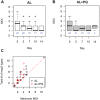Persistence of Plasmodium falciparum parasitemia after artemisinin combination therapy: evidence from a randomized trial in Uganda
- PMID: 27197604
- PMCID: PMC4873826
- DOI: 10.1038/srep26330
Persistence of Plasmodium falciparum parasitemia after artemisinin combination therapy: evidence from a randomized trial in Uganda
Abstract
Artemisinin resistance is rapidly spreading in Southeast Asia. The efficacy of artemisinin-combination therapy (ACT) continues to be excellent across Africa. We performed parasite transcriptional profiling and genotyping on samples from an antimalarial treatment trial in Uganda. We used qRT-PCR and genotyping to characterize residual circulating parasite populations after treatment with either ACT or ACT-primaquine. Transcripts suggestive of circulating ring stage parasites were present after treatment at a prevalence of >25% until at least 14 days post initiation of treatment. Greater than 98% of all ring stage parasites were cleared within the first 3 days, but subsequently persisted at low concentrations until day 14 after treatment. Genotyping demonstrated a significant decrease in multiplicity of infection within the first 2 days in both ACT and ACT-primaquine arms. However, multiple clone infections persisted until day 14 post treatment. Our data suggest the presence of genetically diverse persisting parasite populations after ACT treatment. Although we did not demonstrate clinical treatment failures after ACT and the viability and transmissibility of persisting ring stage parasites remain to be shown, these findings are of relevance for the interpretation of parasite clearance transmission dynamics and for monitoring drug effects in Plasmodium falciparum parasites.
Trial registration: ClinicalTrials.gov NCT01365598.
Figures




References
-
- Organization W. H. World Malaria Report 2014 (2014).
-
- Adjuik M. et al.. Artesunate combinations for treatment of malaria: meta-analysis. Lancet 363, 9–17 (2004). - PubMed
Publication types
MeSH terms
Substances
Associated data
Grants and funding
LinkOut - more resources
Full Text Sources
Other Literature Sources
Medical

